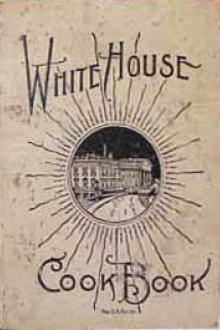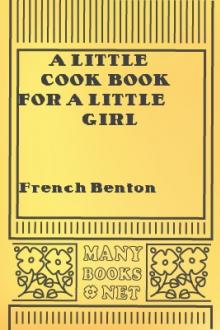The Whitehouse Cookbook (1887), Hugo Ziemann [world of reading .TXT] 📗

- Author: Hugo Ziemann
- Performer: -
Book online «The Whitehouse Cookbook (1887), Hugo Ziemann [world of reading .TXT] 📗». Author Hugo Ziemann
CRISP POTATOES.
Cut cold raw potatoes into shavings, cubes, or any small shape; throw them, a few at a time, into boiling fat and toss them about with a knife until they are a uniform light brown; drain and season with salt and pepper. Fat is never hot enough while bubbling—when it is ready it is still and smoking, but should never burn.
LYONNAISE POTATOES.
Take eight or ten good-sized cold boiled potatoes, slice them end-wise, then crosswise, making them like dice in small squares. When you are ready to cook them, heat some butter or good drippings in a frying pan; fry in it one small onion (chopped fine) until it begins to change color and look yellow. Now put in your potatoes, sprinkle well with salt and pepper, stir well and cook about five minutes, taking care that you do not break them. They must not brown. Just before taking up stir in a tablespoonful of minced parsley. Drain dry by shaking in a heated colander. Serve very hot.
POTATO FILLETS.
Pare and slice the potatoes thin; cut them if you like in small fillets about a quarter of an inch square, and as long as the potato will admit; keep them in cold water until wanted, then drop them into boiling lard; when nearly done, take them out with a skimmer and drain them, boil up the lard again, drop the potatoes back and fry till done; this operation causes the fillets to swell up and puff.
POTATO CROQUETTES. No. 1.
Wash, peel and put four large potatoes in cold water, with a pinch of salt, and set them over a brisk fire; when they are done pour off all the water and mash them. Take another saucepan, and put in it ten tablespoonfuls of milk and a lump of butter half the size of an egg; put it over a brisk fire; as soon as the milk comes to a boil, pour the potatoes into it, and stir them very fast with a wooden spoon; when thoroughly mixed, take them from the fire and put them on a dish. Take a tablespoonful and roll it in a clean towel, making it oval in shape; dip it in a well-beaten egg, and then in bread crumbs, and drop it in hot drippings or lard. Proceed in this manner till all the potato is used, four potatoes making six croquettes. Fry them a light brown all over, turning them gently as may be necessary. When they are done, lay them on brown paper or a hair sieve, to drain off all fat; then serve on a napkin.
POTATO CROQUETTES. No. 2.
Take two cups of cold mashed potatoes, season with a pinch of salt, pepper and a tablespoonful of butter. Beat up the whites of two eggs, and work all together thoroughly; make it into small balls slightly flattened, dip them in the beaten yolks of the eggs, then roll either in flour or cracker crumbs; fry the same as fish-balls.
POTATOES Á LA DELMONICO.
Cut the potatoes with a vegetable cutter into small balls about the size of a marble; put them into a stewpan with plenty of butter and a good sprinkling of salt; keep the saucepan covered, and shake occasionally until they are quite done, which will be in about an hour.
FRIED POTATOES WITH EGGS.
Slice cold boiled potatoes and fry in good butter until brown; beat up one or two eggs, and stir into them just as you dish them for the table; do not leave them a moment on the fire after the eggs are in, for if they harden they are not half so nice; one egg is enough for three or four persons, unless they are very fond of potatoes; if they are, have plenty and put in two.
BAKED POTATOES.
Potatoes are either baked in their jackets or peeled; in either case they should not be exposed to a fierce heat, which is wasteful, inasmuch as thereby a great deal of vegetable is scorched and rendered uneatable. They should be frequently turned while being baked and kept from touching each other in the oven or dish. When done in their skins, be particular to wash and brush them before baking them. If convenient, they may be baked in wood-ashes, or in a Dutch oven in front of the fire. When pared they should be baked in a dish and fat of some kind added to prevent their outsides from becoming burnt; they are ordinarily baked thus as an accessory to baked meat.
Never serve potatoes, boiled or baked whole, in a closely covered dish. They become sodden and clammy. Cover with a folded napkin that allows the steam to escape, or absorbs the moisture. They should be served promptly when done and require about three-quarters of an hour to one hour to bake them, if of a good size.
BROWNED POTATOES WITH A ROAST. No. 1.
About three-quarters of an hour before taking up your roasts, peel middling-sized potatoes, boil them until partly done, then arrange them in the roasting-pan around the roast, basting them with the drippings at the same time you do the meat, browning them evenly. Serve hot with the meat. Many cooks partly boil the potatoes before putting around the roast. New potatoes are very good cooked around a roast.
BROWNED POTATOES WITH A ROAST. No. 2.
Peel, cook and mash the required quantity, adding while hot a little chopped onion, pepper and salt; form it into small oval balls and dredge them with flour; then place around the meat about twenty minutes before it is taken from the oven. When nicely browned, drain dry and serve hot with the meat.
SWEET POTATOES.
Boiled, steamed and baked the same as Irish potatoes; generally cooked with their jackets on. Cold sweet potatoes may be cut in slices across or lengthwise, and fried as common potatoes; or may be cut in half and served cold.
Boiled sweet potatoes are very nice. Boil until partly done, peel them and bake brown, basting them with butter or beef drippings several times. Served hot. They should be a nice brown.
BAKED SWEET POTATOES.
Wash and scrape them, split them lengthwise. Steam or boil them until nearly done. Drain, and put them in a baking dish, placing over them lumps of butter, pepper and salt; sprinkle thickly with sugar, and bake in the oven to a nice brown.
Hubbard squash is nice cooked in the same manner.
ONIONS BOILED.
The white silver-skins are the best species. To boil them peel off the outside, cut off the ends, put them into cold water, and into a stewpan and let them scald two minutes; then turn off that water, pour on cold water salted a little, and boil slowly till tender, which will be in thirty or forty minutes, according to their size; when done drain them quite dry, pour a little melted butter over them, sprinkle them with pepper and salt and serve hot.
An excellent way to peel onions so as not to affect the eyes is to take a pan full of water and hold and peel them under the water.
ONIONS STEWED.
Cook the same as boiled onions, and, when quite done, turn off all the water; add a teacupful of milk, a piece of butter the size of an egg, pepper and salt to taste, a tablespoonful of flour stirred to a cream; let all boil up once and serve in a vegetable dish hot.
ONIONS BAKED.
Use the large Spanish onion, as best for this purpose; wash them clean, but do not peel, and put into a saucepan with slightly salted water; boil an hour, replacing the water with more boiling hot as it evaporates; turn off the water and lay the onions on a cloth to dry them well; roll each one in a piece of buttered tissue paper, twisting it at the top to keep it on, and bake in a slow oven about an hour, or until tender all through; peel them; place in a deep dish and brown slightly, basting well with butter for fifteen minutes; season with salt and pepper and pour some melted butter over them.
FRIED ONIONS.
Peel, slice and fry them brown in equal quantities of butter and lard or nice drippings; cover until partly soft, remove the cover and brown them; salt and pepper.
SCALLOPED ONIONS.
Take eight or ten onions of good size, slice them and boil until tender. Lay them in a baking-dish, put in bread crumbs, butter in small bits, pepper and salt, between each layer until the dish is full, putting bread crumbs last; add milk or cream until full. Bake twenty minutes or half an hour.
A little onion is not an injurious article of food, as many believe. A judicious use of plants of the onion family is quite as important a factor in successful cookery as salt and pepper. When carefully concealed by manipulation in food, it affords zest and enjoyment to many who could not otherwise taste of it were its presence known. A great many successful compounds derive their excellence from the partly concealed flavor of the onion, which imparts a delicate appetizing aroma highly prized by epicures.
CAULIFLOWER.
When cleaned and washed, drop them into boiling water, into which you have put salt and a teaspoonful of flour, or a slice of bread; boil till tender; take off, drain and dish them; serve with a sauce spread over and made with melted butter, salt, pepper, grated nutmeg, chopped parsley and vinegar.
Another way is to make a white sauce (see SAUCES) and when the cauliflowers are dished as above, turn the white sauce over, and serve warm. They may also be served in the same way with a milk, cream, or tomato sauce, or with brown butter.
It is a very good plan to loosen the leaves of a head of cauliflower and let lie, the top downward, in a pan of cold salt water, to remove any insects that might be hidden between them.
FRIED CAULIFLOWER.
Boil the cauliflower till about half done. Mix two tablespoonfuls of flour with two yolks of eggs, then add water enough to make a rather thin paste; add salt to taste; the two whites are beaten till stiff, and then mixed with the yolks, flour and water. Dip each branch of the cauliflower into the mixture, and fry them in hot fat. When done, take them off with a skimmer, turn into a colander, dust salt all over and serve warm. Asparagus, celery, egg-plant, oyster plant are all fine when fried in this manner.
CABBAGE BOILED.
Great care is requisite in cleaning a cabbage for boiling, as it frequently harbors numerous insects. The large drumhead cabbage requires an hour to boil; the green savory cabbage will boil in twenty minutes. Add considerable salt to the water when boiling. Do not let a cabbage boil too long—by a long boiling it becomes watery. Remove it from the water into a colander to drain and serve with drawn butter, or butter poured over it.
Red cabbage is used for slaw, as is also the white winter cabbage. For directions to prepare these varieties, see articles SLAW and SOURCROUT.
CABBAGE WITH CREAM.
Remove the outer leaves from a solid, small-sized head of cabbage, and cut the remainder as fine as for slaw. Have on the fire a spider or deep skillet, and when it is hot put in the cut cabbage, pouring over it right away a pint of





Comments (0)